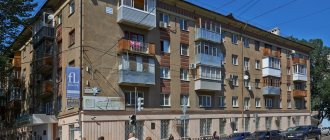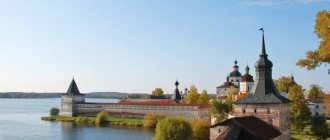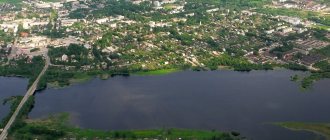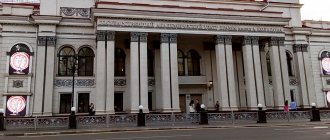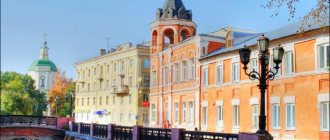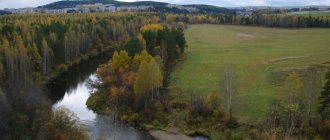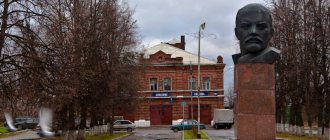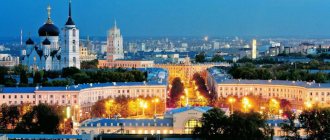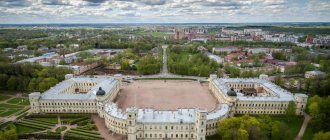Novokhopersk: areas, recreation, excursions, museums and churches, cuisine and restaurants, shopping and shops, attractions of Novokhopersk.
- New Year tours
to Russia - Last minute tours
to Russia
Novokhopersk is an ancient city in the Voronezh region. Until the 17th century Don Cossacks lived in these places; in the 17th century, the population of Novokhopersk took part in the uprisings of Stepan Razin, and a century later the first ships of the Black Sea Fleet were built here.
The historical center of the city is very compact; the five-domed Cathedral of the Resurrection of Christ built in 1865, the ruins of the Church of the Exaltation of the Holy Cross from the 19th century, as well as the buildings of female and male gymnasiums from the early 20th century have been preserved here.
Novokhopersk is also known for its downy goat hair scarves and strange paranormal activities.
Fortress on Khoper
The fortress, which later became the city of Novokhopersk, appeared on the banks of the Khoper River in 1711. According to legend, the drawing of the future fortress was made by Peter the Great himself and handed it over to the Azov governor Apraksin, who, together with the Voronezh governor, began to carry out the imperial order.
Even before the emergence of the fortress, there was a shipyard on Khopra, from which many ships were launched, and in the 18th century, Catherine II made Novokhopersk perhaps the main shipyard of the entire Voronezh region.
It was in Novokhopersk that the future admiral Fyodor Ushakov served: first as a midshipman, and later as a lieutenant in the Don Flotilla.
In 1771, Ushakov participated in the dispatch of the frigate “First”, built at the Novokhoperskaya shipyard, to the Sea of Azov.
Like other settlements and fortresses founded in the late 17th and early 18th centuries on Voronezh land, Novokhopersk became a city during the reign of Catherine the Great, in 1779. From that moment on, he lived a rather measured provincial life, the calm of which was disturbed only by wars. The Khoper Cossack regiment, formed in the city, distinguished itself in the Balkans during the Crimean Wars: then it was the Cossacks who inflicted great damage on the Turkish troops. Another interesting fact: a Czechoslovak brigade under the command of Ludwig Svoboda operated in Novokhopersk during the Great Patriotic War.
Novokhopersk is a historical city in Russia
Administration of the Novokhopersky municipal district Address: Novokhopersk, st. Sovetskaya, 14 Phone: (47353) 3-15-98 Email Website: https://nhoper.ru/
Located 223 kilometers (along the highway) east of Voronezh on the high right bank of the Khoper River and being the administrative center of the municipal district and urban settlement of the same name, the city of Novokhoversk is among 7 cities in the Voronezh region (Bobrov, Boguchar, Borisoglebsk, Voronezh, Novokhopersk, Ostrogozhsk, Pavlovsk) was included in 1990 in the list of historical settlements in Russia, approved by resolutions of the board of the Ministry of Culture of the RSFSR, the board of the State Construction Committee of the RSFSR and the presidium of the Central Council of VOOPIiK.
Wooden sculptural group in honor of Peter the Great in the center of Novokhopersk
However, in July 2010, by a joint order of the Ministry of Culture of the Russian Federation and the Ministry of Regional Development of the Russian Federation, that list was reduced by more than 11 times - from 478 to 41. Moreover, officials who manage the culture and development of Russian regions, according to their own concepts, from the federal list along with all Voronezh such historically significant settlements as Veliky Novgorod, Pereslavl-Zalessky, Pskov, Uglich and even Moscow were erased as historical cities.
Monument to Peter the Great in Moscow
At the same time, as you understand, all these cities have not become any less significant and continue to remain large and small historical centers of Russia in the eyes of Russians. Therefore, leaving behind the officials the right to decide on paper the issues of whether a particular settlement belongs to the historical values of Russia, let’s turn to real life in which Novokhopersk was, is and will remain, albeit small, but certainly a historical city of our region and our country.
Initially located on the outskirts of the Russian state, the lands of modern Prikhoperye only at the beginning of the 17th century began to be populated by all sorts of newcomers (beekeepers, trappers, fishermen) and Cossack freemen. But already in the second half of the 17th century, the Cossacks founded several settlements on the banks of the Khopr - the Cossack riding towns of Belyaevsky, Grigorievsky and Pristansky, which were part of the lands of the Don Army.
Guard Cossack town
Located on the banks of the Khoper, south of the hill on which the historical center of the city of Novokhopersk is now located, the Pristansky town was an important trading point on the so-called “Ordobozarny road”, connecting Moscow (via Ryazan and Kasimov) with Astrakhan, which later became known as the “Khopyorskaya” ”, and in the 18th century it received the name “Astrakhan Highway”.
Former Astrakhan Highway
In 1696, logging work began in Prikhoperye in order to provide material for the shipyards created on Khoper for the construction of ships of the Azov flotilla, which was destined to become the prototype of the regular Russian military fleet.
Construction of ships of the Azov flotilla
Three warships - "Fearlessness", "Good Beginning" and "Connection" - were built and launched in 1698-1699 at the dockyard of the Pristansky town.
Capture of Azov. The first participation of the Russian fleet in hostilities
The participation of the Khoper Cossacks in the Azov campaigns of Peter the Great is written as a separate page in the history of Russia. After the long siege of Azov in 1696, the Khopyorites, who captured the fortress together with the Don people as part of the army of boyar A.S. Shein, showed extraordinary daring and courage. And this was the beginning of the creation of the Khopyor Cossack Regiment.
Participation of the Cossacks in the assault on the Azov fortress
At the end of the Azov campaign, released to their homes, the Khopyor soldiers continued their sovereign service as part of the Khopyor team, formed in 1996 from the Cossacks of the Khopyor Cossack Regiment, located in the settlements of Alferovka, Krasnaya, Pykhovka and Gradskaya.
Cossack outpost
Meanwhile, in 1670-1671, already famous for the participation of its inhabitants - the Khoper Cossacks - in the peasant war led by Stepan Razin, the town of Pristansky in 1708 again found itself at the center of a Cossack uprising led by Kondraty Bulavin, which from here moved to Voronezh and Tambov villages .
This could have been the end of his story, for after the suppression of the Bulavin uprising, which ended with the execution of 7 thousand Cossacks, the Pristansky Cossack town, as the former center of freedom and rebellion, was burned by order of Tsar Peter the Great...
However, soon, again by order of the tsar and according to his plan, a new Khopyorsky earthen fortress was founded on the ashes of Pristansky, with a shipyard attached to it. For on Khoper the construction of ships for the first Azov flotilla began.
In 1710, on the site of the Pristansky town on a high coastal hill, according to a drawing drawn up by Peter I himself, an earthen fortress was founded, the construction of which was completed in 1716. Built to accommodate one and a half thousand service people, the fortress was surrounded by an earthen rampart and wooden towers with 26 cannons. Subsequently called Novaya Khoperskaya, in 1719 it was assigned to the Voronezh province of the Azov province, and the settlements that arose near the fortress laid the foundation for the formation of the future Novokhopersk.
Model of the Novo-Khopyorsky fortress (Novo-Khopyorsky Museum of Local Lore)
By the will of Peter I, 6 warships of the Azov military flotilla were laid down and launched at the New Khoperskaya shipyard. However, the new fortress city acquired all-Russian significance only in the era of Catherine, by whose decree in 1768, the “Don Expedition” was created, led by Rear Admiral, to assist ground forces in the fight against the Turkish fleet and prevent landings on the Black and Azov Seas D. N. Senyavin.
Rear Admiral D.N. Senyavin and the beginning of the construction of ships of the Don Flotilla in Novokhopersk
In 1770, having chosen Novokhopersk as a place for the construction of future ships of the Black Sea Fleet, A. N. Senyavin personally supervised the construction of the new Russian fleet. In 1769-1870, two squadrons were launched from the slipways of the Novokhopyorsk shipyard: the first, consisting of the ships “Taganrog”, “Crown”, the boat “Courier” and the frigate “Second”, and the second squadron consisting of the 16-gun two-masted “Khotin” , the ships "Azov", "Novopavlovsk", "Morey" and the frigate "First".
Construction of ships of the Don Flotilla in Novokhopersk
During those very years, the future naval commander F.F. served in Novokhopersk. Ushakov, whose career began here in 1766-1771 as a midshipman and then as a lieutenant in the Don Flotilla. He made several military passages on ships along the Voronezh rivers; in 1771, he participated in guiding the frigate “First”, built at the Novokhoperskaya shipyard, to the Sea of Azov.
Lieutenant of the Don Flotilla F.F. Ushakov
And in total, during the war with Turkey from 1768 to 1774, more than 30 ships of the Don Flotilla were built at the Novokhopyorsk shipyard - transport ships, galliots, boats and frigates, partly included in the first Black Sea Flotilla, which served as the basis for the Russian Black Sea Fleet.
Black Sea Flotilla
Material evidence of that era is provided by two roads, the cobblestone surface of which has been partially preserved to this day: the “old Cossack road”, windingly descending to Khopr from the place where the eastern gate of the fortress used to be... and the second road, which first went north along the edge of the coastal terrace (now Karl Marx Street), and then went steeply down to the shipyard (Vezzhaya Street).
Remains of the “old Cossack tract” in Novokhopersk
In the era of Catherine II, another page in the history of the Novokhopersky region was turned. On April 24, 1777, the Empress signed a decree on the creation of the Azov-Mozdok line of fortifications to protect the southern borders of the Russian state. And, forced to leave their native land, the Khopyor Cossacks moved to the North Caucasus. There, in the Kuban and Kum, the Khopers created Cossack villages with fortified points at the turn of the new border, which they were destined to defend from the attacks of their Circassian neighbors. In the course of the formation and strengthening of borders, military operations and the transformation of units, the Khopyorsky regimental district of the Batalpashinsky department of the Kuban Cossack army was formed, and the old-line regiment itself began to proudly be called the Khopyorsky Her Imperial Highness Grand Duchess Anastasia Mikhailovna cavalry regiment, which is rightfully considered the oldest and stands at the core Kuban Cossack army.
Relocation of the Khopyor Cossacks to Kuban
The century of Catherine II's reign remained the most important milestone in the history of Novokhopersk. In documents of that time, often called the “New Khoper Fortress,” the city officially received the name “Novokhopersk” and in 1779 became a district town of the Tambov governorship.
Novokhopyorsk is a district town
The same era of Catherine II dates back to the city’s acquisition of its own coat of arms, which was granted the highest on August 16 (old style) 1781 to Novokhopersk, which then belonged to the Tambov governorship, and therefore in the upper part of the city’s coat of arms the Tambov coat of arms was depicted, and in the lower part: “... the river in a green field, on which is written “Novy Khoper”, meaning the name of his city,” this was the true description, which served as the historical basis for the coat of arms of modern Novokhopersk.
Coats of arms of Novokhopyorsk: old and new
In 1883, assigned to the Saratov lands, by decree of Alexander I of March 29, 1802, Novokhopersk again and finally became part of the Voronezh province. And four years later, on March 10, 1806, the city, which had 171 households and 1092 residents, had its first plan approved by the highest order.
First plan of Novokhopersk and bird's eye view of the city
According to this plan, in 1861, on the site of the earthen Khoper fortress (the earthen rampart of which was razed in 1851), the construction of the current Resurrection Cathedral began, built in the Russian-Byzantine style, according to the exemplary design of the architect K.S. Tone and is now the hallmark of the city.
Resurrection Cathedral and a view of the surroundings of Novokhopyorsk from the height of its domes
The construction of the Resurrection Cathedral coincided with the transfer of the Epiphany Fair to Novokhopyorsk from the Mikhailovskaya village - one of the largest in Russia at that time, which played a special role in the development of the city.
Held annually in Novokhopyorsk for five years until 1871, the Epiphany Fair brought the city an income of 50 thousand rubles a year. According to contemporaries, over these years Novokhopyorsk “has changed so much that anyone who was there a few years ago would now absolutely not recognize it.”
The last decades of the 19th century were years of intensive construction and renewal of the city. Shipping along the Khoper River is developing, cargo turnover for the transport of wheat, alcohol, and timber is increasing, grain trade is expanding, and grain buying offices are opening. In 1895, railway sections of the new latitudinal line Kharkov-Balashov-Penza were laid through Novokhopyorsky district and a new railway station was formed - Novokhopyorsk.
The advent of railway transport gave a new impetus to the development of Novokhopyorsk: by 1916, in the city, whose population was 9.1 thousand inhabitants, there were 20 factories (including a steam oil mill), a commodity mill, as well as 10 educational institutions (including including male and female gymnasiums, primary school, 7 primary schools).
About 60 buildings built at the turn of the 19th and 20th centuries are now included in the list of historical and architectural monuments. The most notable of these is the former men's gymnasium, built in late modernist forms in 1907 and considered the city's largest public building of the early 20th century.
Men's gymnasium
After the victory of the armed uprising in Petrograd, Novokhopyorsk entered the newest period of its history. On November 2 (15), 1917, Soviet power was established in the city. Moreover, this happened peacefully, and Novokhopyorsk was included in the number of the first Soviet cities in the Voronezh province.
During the Civil War, the Novokhopyorsky region became the scene of fierce battles between Red Army units and White Guard troops. The history of the Voronezh region of the Soviet period includes the Krasnyansky uprising, which broke out in the rear of the white troops who captured the territory of the Novokhopyorsky district.
In July 1919, residents of the villages of Krasnoye, Nekrylovo, Kamenka-Sadovka, Pykhovka, Burlyaevka and Troitskoye took up arms against the rampaging White Guards. The uprising was suppressed by units of the White Guard army, but the fighting continued for a long time. And most importantly, these armed actions in the rear of the White Guards helped the Red Army at the end of July 1919 to liberate Novokhopersk and most of the district, where Soviet power was restored.
Monument in honor of the participants of the Krasnya uprising (Krasnoe village)
In 1920-1921, part of the territory of Novokhopyorsky district was covered by one of the largest peasant uprisings in Russia against the power of the Soviets during the Civil War.
The rebel peasants and their leader Ivan Kolesnikov
Sometimes called “Antonovism” after the name of one of the leaders of the uprising, it began in the Tambov province, from where it spread to the western southern districts of the Voronezh province, where the “Antonovites” were supported by the “Kolesnikovites” - the rebel peasants of Staraya Kalitva, led by Ivan Kolesnikov, who joined the ranks "Antonov" army by the 1st Bogucharsky partisan regiment.
I.S. Kolesnikov is the commander of the First Cavalry Rebel Army of the United Partisan Army of the Tambov Province.
The future Marshal G.K. took part in the suppression of the peasant uprising. Zhukov and children's writer A.P. Gaidar. Having fought in the vicinity of Novokhopersk, they later talked about it: Zhukov - in his memoirs, Gaidar - in the story “School”.
Participants in the battles on Novokhopyorsk land G.K. Zhukov and A.P. Golikov (Gaidar)
Some episodes of the Civil War on the territory of Novokhopersky district also served as literary material for A.P. Platonov is one of the most original Russian writers in style of the first half of the 20th century. In the summer of 1919, sent to Novokhopersk as a correspondent for Izvestia of the Defense Council of the Voronezh fortified area, he subsequently wrote: “July 1919 was hot and alarming. I did not feel safe in the small houses of the city of Novokhopersk, I was afraid of privacy in my room and sat more in the yard... In a short time, the power here changed six times - first red, then white, then red again...” So, thanks to the impressions from that business trip, Novokhopersky district became the setting for the socio-philosophical novel “Chevengur” - written in 1926-1928, the most extensive and one of the most significant works of the master.
A. Platonov among the delegates of the provincial congress of journalists (1921)
Already in peacetime, during the years of the first five-year plans, Novokhopyorsk was mentioned in the novel by I. Ilf and E. Petrov “The Twelve Chairs”: in a note addressed to Madame Gritsatsueva, Ostap Bender reported that it was to this city that he should urgently go with a report. Apparently, Novokhopyorsk was then perceived in Soviet Russia as a symbol of the new Russian province.
To this day, one of the city’s attractions is the monument to V.I. Lenin, opened on May 1, 1924, almost the very first in the Voronezh province.
In 1928, a so-called zoning campaign took place throughout the USSR, during which the Novokhopyorsky district, abolished together with the Voronezh province, was transformed into one of the districts of the Central Black Earth Region.
A historical feature of the existence of the Novokhopersky district of that period is the fact that, starting from its creation in 1928, its territory was divided into two districts - Novokhopersky and Elan-Kolenovsky, which existed in this status until 1965, until they were united within the borders of modern Novokhopersky district. And therefore, in order not to get confused in time and space, local historians consider this period of the history of the region as a single whole.
The general history of the Novokhopersky region of the pre-war period includes two events, each of which is worthy of being called historical. On February 10, 1935, by the Decree of the All-Russian Central Executive Committee and the Council of People's Commissars of the RSFSR, the Khopersky State Reserve was created with the aim of protecting and restoring the number of valuable fur-bearing animals - the Russian muskrat.
And on November 6, 1939, the now famous sugar factory, which in those years was one of the largest industry enterprises in Europe, came into operation.
In 1941-1943, a front-line city where military hospitals were located and military units were formed to be sent to the front, Novokhopersk is inscribed in the pages of the history of the Great Patriotic War as the place of formation of the First Czechoslovak Brigade under the command of the future President of Czechoslovakia, Ludwig Sloboda.
Bringing the banner into the headquarters of the 1st Czechoslovak Brigade
This event is recalled by a memorial plaque on the building of the local history museum, where in May-September 1943 the headquarters of the Czechoslovak brigade was located, and in our time the first in the USSR and the only museum in the world of Soviet-Czechoslovak friendship is located.
During the Great Patriotic War, more than 14 thousand residents of Novokhopersk and the Novokhopersk region went to the front, and, without returning, almost 8 thousand Novokhopersk residents fell in battle for their homeland.
Memorial of the Great Patriotic War in Novokhopyorsk
Busts of 12 Heroes of the Soviet Union - residents of the Novokhopyorsk region - are installed in Novokhopersk on the Walk of Fame.
Walk of Fame in Novokhopyorsk
Since its foundation as a fortified city, one of the symbols of Novokhopyorsk has been the Khopyor River. Flowing through the territory of the Novokhopyorsky region, one of the most beautiful and cleanest rivers in Europe, it gave its name to the city and is now the main image of its modern coat of arms.
Khoper River
In the floodplain of this amazing and crystal clear river is the territory of the Khopyorsky State Nature Reserve, which, in turn, being the standard of nature of the Central Black Earth Region, is presented in all guidebooks to the Voronezh region as one of the main attractions of the region and the Novokhopyorsky district, in particular.
The central estate of the reserve in the village. Varvarino
This place has such a diverse flora and fauna that it is one of the most famous protected areas in the world. The Khopyorsky State Nature Reserve has gained particular popularity due to the distribution of a relict animal in it - the Russian muskrat.
On the banks of the Khopra, not far from Novokhopersk, there is another attraction of all-Russian significance. Known as the Novokhopyorsk anomalous zone, it is located on the site of the Novokhopyorsk tectonic fault of the earth’s crust in the area of Lake Zheltoyar, where researchers have identified an extraordinary concentration of anomalous phenomena.
Lake Zheltoyar and Novokhopyorskaya anomalous zone
The phenomenon of the anomalous zone near Novokhopyorsk began to be studied back in the mid-1980s. Having identified a tectonically active area, an expedition led by the famous Voronezh ufologist Genrikh Silanov studied rare phenomena for several years, using the Novokhopyorsk anomalous zone as a natural testing ground.
Genrikh Silanov and his photographs
And finally, in 2013, Novokhopyorsk once again attracted the attention of all of Russia due to a wave of protests that swept through the Voronezh region and its bordering regions in the east, in connection with the planned development of nickel deposits on the banks of the Khoper River.
Under the motto “In Defense of Khopr,” the protest movement demanded to prevent the development of nickel deposits, because this activity will inevitably affect the deterioration of the environmental situation in the region. At the same time, people were also concerned about the fate of the Khopyorsky Nature Reserve located next to the mining area.
However, despite the protests, exploration continued, ending in 2017. And already next year it became known that the construction of a mining enterprise in the Novokhopyorsky district could begin in 2021, and the commissioning of the deposit is planned for July 2026.
Novokhopersky souvenirs
The most important brand and souvenir that you can bring from Novokhopersk are down scarves and other products made from sheep wool and goat down. This trade has been practiced in the east of what is now the Voronezh region for decades, and knitting technologies are passed on from generation to generation. By and large, the production of Novy Khoper scarves is the most important artistic craft in these parts. The scarves and scarves that local craftswomen create have a variety of designs - “flowers”, “chains”, “snowflakes”, “circles”, “snakes” and others - depending on your imagination and skills. There are two varieties of Novy Khoper scarves: winter ones, which are knitted tightly in two threads, and summer ones, in one thread with openwork patterns.
Novokhoperskaya anomalous zone
For several decades, everyone who is interested in paranormal phenomena and believes in the supernatural has been drawn to Novokhopersk like a magnet.
Glowing balls, ghosts, fast-growing plants, clock hands losing their rhythm, silhouettes of soldiers - all this and much more, according to their own stories, was seen by eyewitnesses in the Novokhopyorsk anomalous zone.
Such phenomena in this zone, according to researchers, occur due to the fact that a tectonic fault formed in the earth’s crust in these places several billion years ago. Because of it, in the anomalous zone, again, according to those interested in paranormal phenomena, one can observe ghosts - people who died hundreds of years ago, and the events of that time. One of the researchers even managed to record one of these events with a camera - the stay of soldiers of the Czechoslovak brigade on the banks of the Khoper during the Great Patriotic War.
Novokhopersk 300 years old
Sights of Novokhopersk
Despite two wars and a revolution, pre-revolutionary buildings have been preserved in Novokhopersk. Many of the ancient buildings are of interest as tourist sites. For example, the city can be proud of the preserved religious buildings of the 19th century - the Resurrection Cathedral and the Trinity Church, remarkable architectural monuments of their time.
But this is not the most unusual thing in Novokhopersk - not churches or secular buildings.
Perhaps the main attraction of Novokhopersk is the one-of-a-kind museum of the history of Soviet-Czechoslovak friendship.
It is located in an old merchant's house, where the headquarters of the first Czechoslovak brigade, which was part of the Red Army and took part in the battles of the Great Patriotic War on the side of the USSR, was located.
Once in the Novokhopersky district, it would be strange not to visit the Khopersky Nature Reserve with its ancient estate and eco-trails. It was created to protect the Russian muskrat and other valuable animals and plants and has been performing its functions for many years. In the reserve you can visit the nature museum, just stroll around the territory and enjoy the protected nature.
What to see
Khopersky State Reserve
How much: admission to the territory of the reserve - 150 rubles per person. The cost of excursions depends on the route and the number of tourists. Bicycle rental – 150 rubles.
When: excursions by arrangement by phone (47353) 4 81 50.
The central estate is located in the village of Varvarino, 20 km from Novokhopersk. The preserved Baranov estate is also located here. The lands on which the village was located belonged to Count Nikita Shemyakin, who bought them in the mid-19th century from Prince Grigory Potemkin for the dowry of his daughter Varvara Nikolaevna. Until 1917, the village had a stone church, a school, a tavern, a steam mill, and a distillery. In Varvarino, the house of the manager of the 5th Alferovsky Appanage estate built at the end of the 19th century, the building of the former zemstvo school and an extensive brick basement for storing perishable food have been preserved.
There are five ecological routes and a nature museum on the territory of the reserve. In the summer of 2021, the reserve opened a 26 km long “Tour de Hoper” cycling trail, which tourists cover in about 4 hours. If you have a special permit, you can kayak on the Khopru River.
Visiting the territory of the reserve is possible by personal transport, ecological trails - by transport of the reserve.
Khoper anomalous zone
On the bank of the Khopra River not far from Novokhopersk, at the site of a tectonic fault in the earth’s crust, is Zheltoyar. According to some ufologists and paranormal researchers, this is one of the strongest anomalous zones in Russia. In particular, they claim that here, with the help of special equipment, UFOs of various shapes and plasma balls were photographed, and the “field memory” effect was discovered, when on photographic film one can distinguish the silhouettes of people and objects that were at this place decades ago.
Novokhopersky Museum of Local Lore
How much: for adults – 50 rubles, video filming – 100 rubles, photography – 50 rubles.
When: daily from 8:00 to 17:00. On weekends only by prior arrangement.
The Novokhopersky Museum of Local Lore is located in a two-story mansion built in 1870. Initially it was a residential building, and since the 1930s only military headquarters were located there. From May to September 1943, the First Czechoslovak Brigade was formed in Novokhopersk under the command of Ludwik Svoboda. Her headquarters were also located here. In 1961, the President of Czechoslovakia, Ludwik Svoboda, visited Novokhopersk. By 1973, a small museum of Soviet-Czechoslovak friendship was created in one of the rooms on the first floor. Now it is the only museum of its kind in the post-Soviet space.
In one of the halls of the museum there is a gallery of the artist, member of the Russian Academy of Arts, Anatoly Popov. His great-great-grandfather, the famous Itinerant artist, student of Alexei Savrasov, Alexander Popov, is buried in the village of Podgorny, Novokhopersky district.
Alferovsky Great Oak and observation deck
In Alferovka, located 20 km from Novokhopersk, there is one of the main natural attractions0 of the region0 - the Great Oak. In 2014, the tree was included in the register of old-growth, unique trees in Russia. Its height is 31 meters, girth is 479 centimeters, age is 151 years.
From the observation deck in Alferovka there is a view of the Khoper River and the reserve.
Memorial sign at the burial site of Raevsky in Krasnoe
Lieutenant General Nikolai Raevsky (junior) is the son of a commander, hero of the War of 1812. Together with his father and older brother, he took part in the famous battle of Saltanovka, in the foreign campaigns of 1813 and 1814, and was awarded the Order of St. Vladimir, 4th degree, for his distinction in the capture of Paris. In addition to many other services to the Fatherland, Raevsky went down in history as the founder of Novorossiysk and the head of the 1st department of the Black Sea coastline.
Nikolai Raevsky received Sloboda Krasnenkaya (now called Krasnoe) as a dowry for his wife Anna Borozdina.
In the summer of 1843 he fell ill and died suddenly.
Through the efforts of local local historian Nadezhda Chaplieva, the burial site was established, where a memorial sign was unveiled in 1995.
10 km from Krasnoye is the only surviving Raevsky estate - the Kalinovskaya dacha. The estate preserved the park of Mikhail Nikolaevich Raevsky with 30 species of exotic plants.
